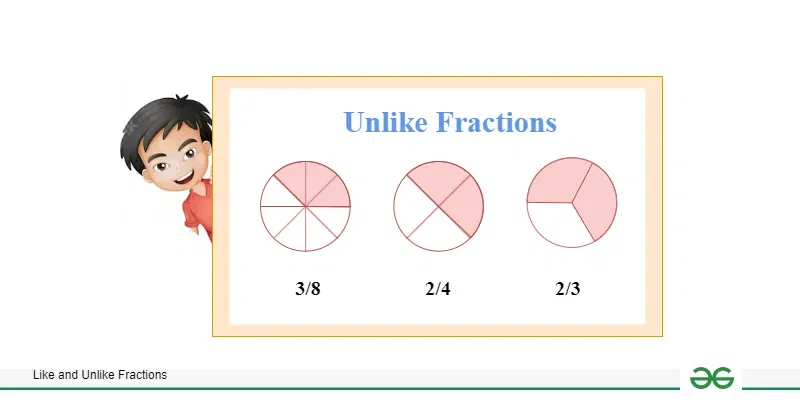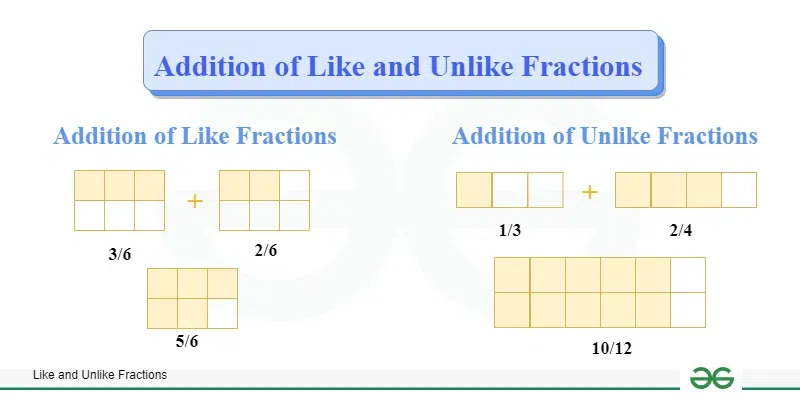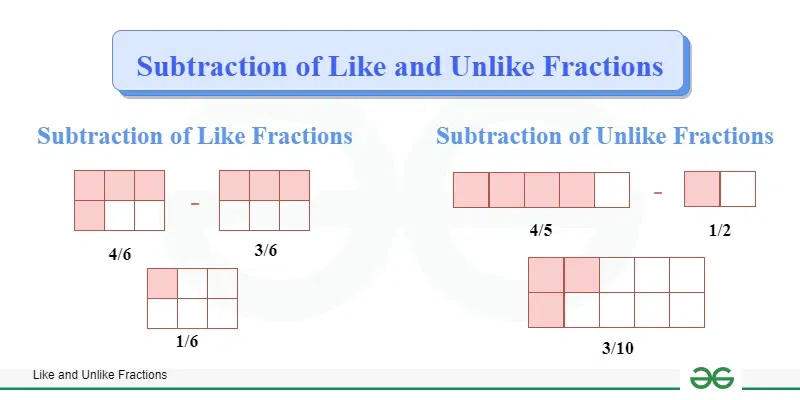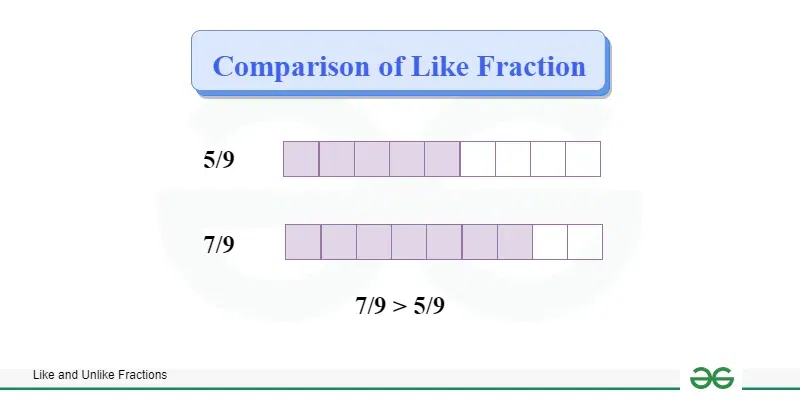Like and Unlike fractions are the two types of fractions based on the value of their denominators. In Like fractions, all the fractions have the same denominator. On the contrary, unlike fractions have different numbers in their denominators.
In this article, we will discuss about like and unlike fractions, their definitions and examples, arithmetic operations on like and unlike fractions, and conversion of unlike fractions to like fractions. We will also solve some examples related to like and unlike fractions.
What are Like and Unlike Fractions?
Fractions with same denominators are known as like fractions whereas the fractions with different denominators are known as unlike fractions.
In other words, the fractions whose denominators are identical is termed as like fractions and the fractions whose denominators are not identical are termed as unlike fractions.
Like Fraction Definition
The fractions with the equal denominators are called like fractions. The two fractions p/q and r/s are said to be like fraction when the denominators q and s are equal (i.e. q = s).
Like Fraction Examples
Some examples of like fractions are:
- 1/5 and 7/5 (denominators of both the fractions are equal so these fractions are like fractions)
- 1/7, 6/7 and 3/7 (denominators of all the fractions are equal so these fractions are like fractions)

Examples of Like Fractions
Unlike Fraction Definition
The fractions with the unequal denominators are called unlike fractions. The two fractions p/q and r/s are said to be unlike fraction when the denominators, q and s are not equal ( i.e. q ≠ s).
Unlike Fraction Examples
Some examples of unlike fractions are:
- 1/3 and 4/9 (denominators of both the fractions are not equal so these fractions are unlike fractions)
- 1/2, 6/5 and 3/4 (denominators of all the fractions are not equal so these fractions are unlike fractions)

Examples of Unlike Fractions
Conversion of Unlike Fractions to Like Fractions
We can easily convert unlike fractions to like fractions. Following are the steps to convert unlike fractions to like fractions:
- First, take the LCM of all the denominators of unlike fractions.
- Then, multiply and divide each fraction by such a number so that the denominator becomes equal to the LCM of the denominators.
- The resultant fractions are like fractions.
- Hence, the unlike fractions are converted into like fractions.
Let us consider an example to understand this better.
Example: Convert the given unlike fractions 4/5 and 9/2 to like fractions.
Solution:
First, we find LCM of 5 and 2 = 10
Then, multiply and divide each fraction by such a number that their denominator becomes equal to the LCM, i.e. 10
(4/5) × (2/2) = 8/10
(9/2) × (5/5) = 45/10
So, the equivalent like fractions are 8/10 and 45/10.
Arithmetic Operations on Like and Unlike Fractions
The arithmetic operations on like and unlike fractions are:
Let’s learn about these operations one by one.
Addition of Like and Unlike Fractions
The method and formula to add like and unlike fraction is given below:
Addition of Like Fractions
To add like fractions, we just add the numerators of the fraction and put the denominator as it is. Let p/q and r/q are two like fractions then,
(p/q) + (r/q) = (p + r) / q
Example: Add 3/6 and 2/6
Solution:
3/6 and 2/6 are like fractions.
Adding these two we get:
(3/6) + (2/6) = (3 + 2) / 6
(3/6) + (2/6) = 5/6
Addition of Unlike Fractions
To add unlike fractions, first we take LCM of the denominators and then multiply and divide the fractions by a number such that the denominators of fractions is equal to the LCM of the denominators.
Example: Add 1/3 and 2/4.
Solution:
1/3 and 2/4 are two unlike fractions. To add these two unlike fractions we follow below steps.
- Find LCM of 2 and 5 i.e., denominators, LCM(3, 4) = 12
- Multiply and divide by 4 in 1/3 gives 4/12.
- Multiply and divide by 3 in 2/4 gives 6/12.
- Now the above two unlike fractions are converted into like fractions.
- So, add 4/12 and6/12.
- (4/12) + (6/12) = (4 + 6)/12 = 10/12.
Hence, 1/3 + 2/4 = 10/12

Addition off Like and Unlike Fractions
Subtraction of Like and Unlike Fractions
The method and formula to subtract like and unlike fraction is given below:
Subtraction of Like Fractions
To subtract like fractions, we just subtract the numerators of the fraction and put the denominator as it is. Let p/q and r/q are two like fractions then,
(p/q) – (r/q) = (p – r) / q
Example: Solve 4/6 -3/6.
Solution:
4/6 and 3/6 are like fractions.
Subtracting these two:
(4/6) – (3/6) = (4 – 3) / 6
Hence, 4/6 -3/6 = 1/6
Subtraction of Unlike Fractions
To subtract unlike fractions, first we take LCM of the denominators and then multiply and divide the fractions by a number such that the denominators of fractions is equal to the LCM of the denominators.
Example: Subtract 1/2 from 4/5.
Solution:
1/2 and 4/5 are two unlike fractions. To subtract these two unlike fractions follow the below given steps:
- Find LCM of 2 and 5 i.e., denominators LCM(2, 5) = 10
- Multiply and divide by 5 in 1/2 to get 5/10.
- Multiply and divide by 2 in 4/5 to get 8/10.
- Now the above two unlike fractions are converted into like fractions.
- So, subtract 8/10 and 5/10.
- (8/10) – (5/10) = (8 – 5)/10 = 3/10.
Hence 4/5 – 1/2 = 3/10

Subtraction of Like and Unlike Fractions
Multiplication of Like and Unlike Fractions
The method and formula to multiply like and unlike fraction is given below:
Multiplication of Like Fractions
To multiply like fractions, we multiply the numerators and denominators of the fraction. Let p/q and r/q are two like fractions then,
(p/q) × (r/q) = (p × r) / (q × q)
Example: Find the product of 2/7 and 4/7.
Solution:
2/7 and 4/7 are like fractions.
Multiplying these two we get:
(4/5) × (7/5) = (4 × 7) / (5 × 5)
Hence, 4/5 × 7/5 = 28/25
Multiplication of Unlike Fractions
To multiply unlike fractions, we multiply numerators and denominators separately similar to like fractions. Let p/q and r/s are two unlike fractions then,
(p/q) × (r/s) = (p × r) / (q × s)
Example: Simplify 3/2 × 4/5.
Solution:
3/2 and 4/5 are two unlike fractions.
Multiplying these two unlike fractions,
(3/2) × (4/5) = (3 × 4) / (2 × 5)
Hence, 3/2 × 4/5 = 12/10
Division of Like and Unlike Fractions
The method and formula to divide like and unlike fraction is given below:
Division of Like Fractions
To divide like fractions, we take reciprocal of the second fractions and then multiply them accordingly. Let p/q and r/q are two like fractions then,
(p/q) ÷ (r/q) = (p/q) × (q/r) = p/r
Example: Divide 4/5 by 7/5.
Solution:
4/5 and 7/5 are like fractions.
Dividing these two:
(4/5) ÷ (7/5) = (4/5) × (5/7) = (4 × 5) / (5 × 7)
Hence, 4/5 ÷ 7/5 = 4/7
Division of Unlike Fractions
To divide unlike fractions, we divide them by taking reciprocals of the second fraction and then multiplying them accordingly. Let p/q and r/s be two unlike fractions then,
(p/q) ÷ (r/s) = (p/q) × (s/r) = (p × s) / (q × r)
Example: Divide 3/2 by 4/5.
Solution:
3/2 and 4/5 are two unlike fractions. To divide these two unlike fractions,
(3/2) ÷ (4/5) = (3/2) × (5/4)
= (3 × 5) / (2 × 4)
= 15/8
Hence, 3/2 ÷ 4/5 = 15/8
Comparison of Like Fractions
For comparing the like fractions, we just compare the numerators of the fractions. Larger the numerator, larger is the fraction. Below is an example of comparison of like fractions:
Example: Compare the like fractions 4/5, 1/5, 9/5, 6/5 and arrange them in ascending order.
Solution:
Given Like fractions are 4/5, 1/5, 9/5, 6/5
Since, the given fractions are like fractions we compare the numerators of the fractions. Larger the numerator larger the fraction.
1 < 4 < 6 < 9
The ascending order of like fraction is 1/5 < 4/5 < 6/5 < 9/5.
Comparison of Unlike Fractions
The comparison of unlike fractions can be done in two ways according to the type of unlike fraction i.e:
- Unlike Fractions with same numerators
- Unlike Fractions with different numerators
Comparison of Unlike Fractions with Same Numerators
If the numerators of the unlike fractions are same then, we can compare these fractions according to the value of their denominator. In this case smaller the denominator, larger is the fraction. Let’s take an example for the same:
Example: Compare the unlike fraction 4/6, 4/9, 4/3 and arrange them in ascending order.
Solution:
The given unlike fraction is 4/6, 4/9, 4/3.
Since, the numerators of all fractions is 4. So, we compare denominators such that smaller the denominator larger the fraction.
Denominators: 3 < 6 < 9
Fraction: 4/3 > 4/6 > 4/9
Ascending order of given unlike fraction is 4/9 < 4/6 < 4/3.

Comparing Like Fractions
Comparison of Unlike Fractions with Different Numerators
For comparing unlike fractions with different numerators we have two methods:
- Cross Multiplication
- LCM method
Method 1: Cross Multiplication
In cross multiplication method, we take product of first fraction numerator with the denominator of second fraction and compare it with the product of second fraction numerator with first fraction denominator. Based on this comparison we get larger or smaller fractions.
Example: Compare the unlike fractions 5/8 and 2/3 by cross multiplication method.
Solution:
The given unlike fractions are 5/8 and 2/3
By Cross multiplication method, we have
5 × 3 , 2 × 8
15 < 16
Hence, 5/8 < 2/3
Method 2: LCM Method
In this method, we will follow the given steps:
- First, we convert unlike fractions to like fractions by taking LCM of all the denominators.
- Then we multiply numerator and denominator of each fraction with such a number that its denominator becomes equal to the LCM.
- Now, we the obtained fractions will be like fractions and we can easily compare them with their numerators.
Example: Compare the unlike fractions 5/7 and 4/3 by LCM Method.
Solution:
First, take LCM of 7 and 3 = 21
Now, convert the fractions to like fractions
5/7 = (5 × 3) / (7 × 3) = 15/ 21
4/3 = (4 × 7) / (3 × 7) = 28/21
So, the equivalent like fractions are 15/21 and 28/21.
Since, the fractions are converted into like fractions we compare numerators.
15 < 28
15/21 < 28/21
Hence, 5/7 < 4/3

Comparing Unlike Fractions
Difference Between Like and Unlike Fractions
Below is the comparison table of like and unlike fractions:
|
Characteristics
|
Like Fractions
|
Unlike Fractions
|
|
Definition
|
Fractions with same denominator.
|
Fractions with different denominators
|
|
Representation
|
Fractions p/q and r/s are said to be like fractions if and only if q = s.
|
Fractions p/q and r/s are said to be unlike fractions if and only if q ≠ s.
|
|
Examples
|
Example of like fractions is 2/7 and 4/7.
|
Examples of unlike fractions is 4/9 and 6/7.
|
Read More About,
Solved Examples on Like and Unlike Fractions
Example 1: Identify whether the given fraction is like or not: 4/5, 7/5 and 12/5.
Solution:
In the given fractions 4/5, 7/5 and 12/5, denominator = 5
i.e., denominator is same for all three fractions.
So, the given fractions are like fractions.
Example 2: Add the fractions 2/3 and 7/2.
Solution:
Given fractions 2/3 and 7/2 are unlike fractions.
First, we take, LCM of denominators.
LCM of 3 and 2 is 6.
Now, we multiply the numerator and denominator with such a number that the denominator results in LCM.
First fraction = 2/3 = (2/3) × (2/2) = 4/6
Second Fraction = 7/2 = (7/2) × (3/3) = 21/6
Adding the above two converted like fractions.
(2/3) + (7/2) = (4/6) + (21/6)
= (4 + 21)/6
= 25/6
Hence, (2/3) + (7/2) = 25/6
Example 3: Subtract 4/5 from 11/5.
Solution:
Given fractions are 4/5 and 11/5 are like fractions.
(11/5) – (4/5) = (11 – 4) / 5
(11/5) – (4/5) = 7 / 5
Example 4: Multiply 5/3 and 2/3.
Solution:
We have (5/3) × (2/3)
= (5×2) / (3×3)
= 10 / 9
Example 5: Divide (1/3) by (4/3)
Solution:
We have (1/3) ÷ (4/3)
= (1/3) × (3/4)
= (1 × 3) / (3 × 4)
= 3/12 = 1/4
Practice Questions on Like and Unlike Fractions
Q1. Add the fractions: 5/9 and 10/9.
Q2. Subtract 12/7 from 3/2.
Q3. Multiply 4/6 and 5/4.
Q4. Divide 2/5 with 3/2.
Q5. Identify the given fractions are like fractions or unlike fractions: 5 /6, 3 /7 and 8/3.
Like and Unlike Fractions: FAQs
What are Like Fractions?
Fractions with the same denominators are referred to as like fractions.
What are Unlike Fractions?
Fractions that have different denominators are referred to as unlike fractions.
How do we Compare Unlike Fractions?
To compare unlike fractions we first take LCM of denominators. after that we multiply and divide each fraction by such a number so that denominators become equal to LCM. Now, we will compare the numerators of the resultant fractions.
What are Examples of Like and Unlike Fractions?
- Examples of like fractions are: 1/2, 7/2, 2/2, 6/2.
- Examples of unlike fractions are: 3/4, 1/5, 2/6, 7/3.
How to Convert Unlike Fractions to Like Fractions?
To convert unlike fractions to like fractions we first take LCM of denominators. after that we multiply and divide each fraction by such a number so that denominators become equal to LCM. Hence, the resultant fractions are like fractions.
Share your thoughts in the comments
Please Login to comment...